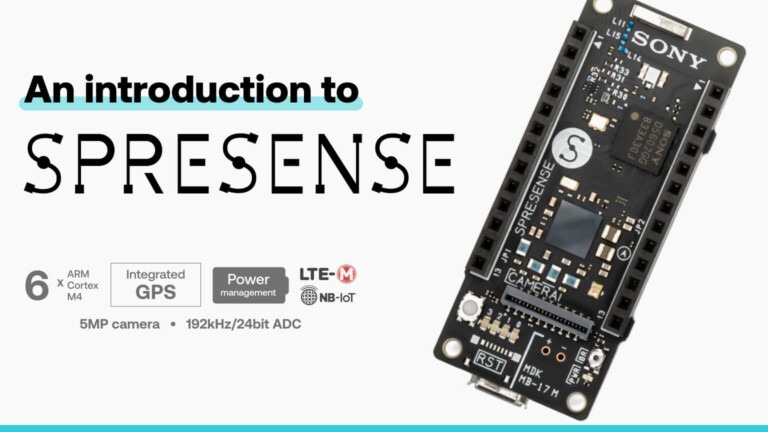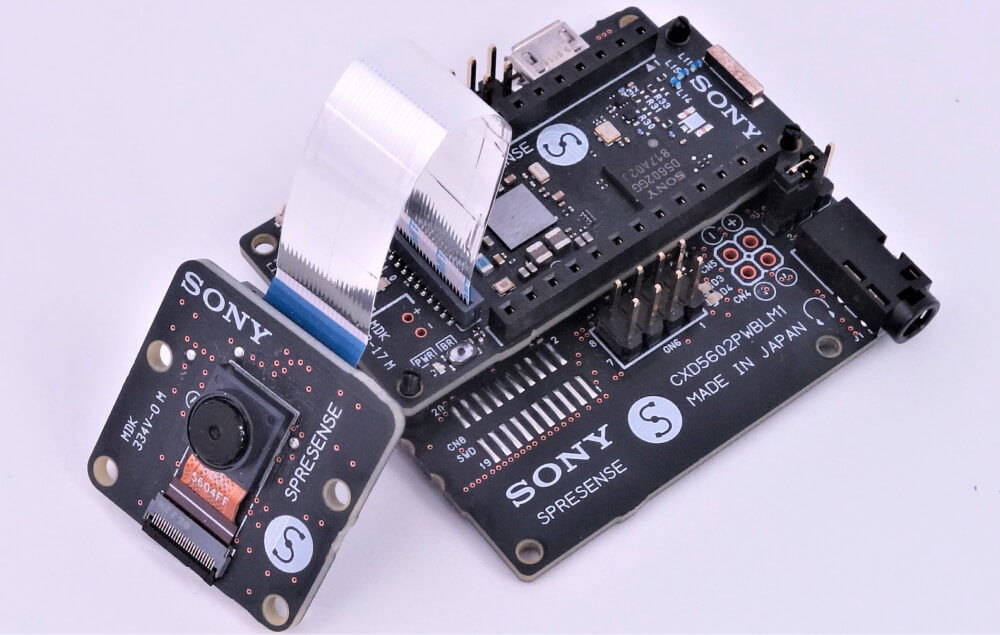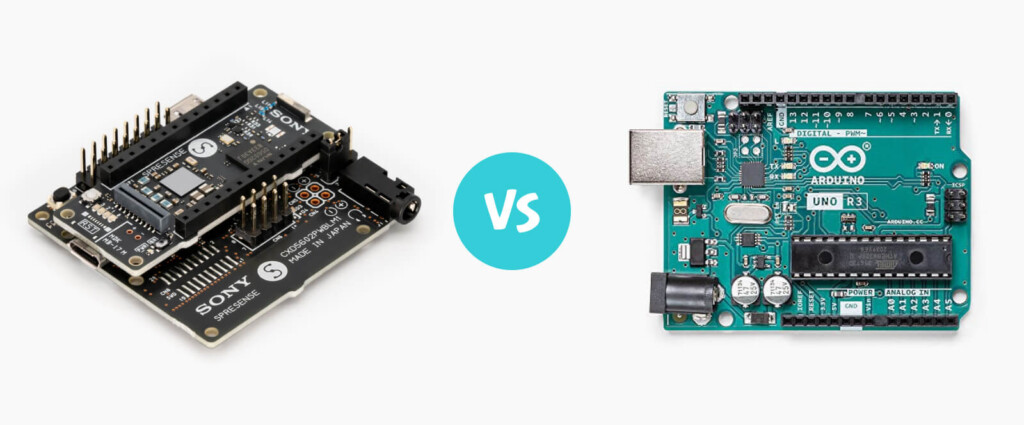An Introduction to Sony’s Spresense Microcontroller Board

The Spresense IoT Microcontroller from Sony Semiconductor Solutions was initially launched in July 2018 and immediately won over developers with its impressive performance capabilities along with its ability to keep power consumption extremely low when deployed in the field.
Since then, Sony has developed the board further – adding hardware extensions such as an HDR Camera Board, sensor add-ons, and LTE Cat-M1 (LTE-M) connectivity.
In this article, we’ll dive deeper into the Spresense board from Sony, and weigh up how it compares to other solutions in the market for IoT developers.
In this article:
- What is Sony’s Spresense?
- What Use Cases is Spresense built for?
- What hardware extensions does Sony’s Spresense support?
- How does Spresense connect over cellular?
- What development languages does Spresense support?
- Sony’s Spresense vs Arduino
- Conclusion
What is Sony’s Spresense?
Sony’s Spresense is a compact high-performance 6-core microcontroller board that offers dynamic computing capabilities and power consumption so low the device can run on a battery.
The board has been designed to provide a versatile IoT development experience capable of supporting a range of use cases. Some examples include:
- A drone utilizing the internal GPS and high-performance processor
- A smart speaker utilizing hi-res audio recording and playback, as well as the built-in class D amplifier
- A low-power time-lapse camera utilizing the dedicated 8-bit parallel camera interface.
The Spresense is powered by Sony’s CXD5602 microcontroller, which runs on 6 ARM Cortex-M4F cores with a clock speed of up to 156MHz. Due to the Fully Depleted Silicon On Insulator (FD-SOI) production process, the CXD5602 is capable of remarkable energy efficiency, making it ideal for IoT applications reliant on batteries.
What Use Cases is Spresense built for?
The unique capabilities of Spresense mean it can support a vast range of IoT use cases.
With its combination of processing power and energy efficiency, the device is ideal in deployments that involve sensor analysis, machine learning, image processing, and data filtering, providing resilient, reliable performance where other microcontroller-based alternatives fall short.
Spresense is perfect for IoT applications in virtually any industry, including:
✅ Logistics and transport
✅ Automatic quality inspection
✅ Predictive maintenance
✅ Wildlife monitoring
✅ Cell tower remote inspection
✅ Industrial connectivity
✅ Gesture recognition
✅ AI camera applications
✅ Sound diagnostics
✅ Home automation
✅ Edge computing
✅ FFT calculations
✅ Robotics and drone control
✅ GPS tracking
✅ Remote monitoring
✅ Image processing
✅ Real-time sensor analysis
✅ Hi-res audio solutions
What hardware extensions does Sony’s Spresense support?
While Sony’s Spresense boasts a number of powerful features – including integrated GPS, high-res audio output, multiple microphone inputs, and a dedicated camera interface for Sony’s own 5MP CMOS sensor – it can be paired with numerous hardware extensions to amplify its capabilities even further.

The main board can be plugged into the Spresense extension board, which provides a 3.5mm headphone jack, micro SD card slot, an additional USB port, as well as 4 analog and 8 digital microphone inputs.
Depending on the use case, the main board is also compatible with several add-on boards and external modules that can provide additional sensor and connectivity options, such as accelerometers, or WiFi.
- Spresense HDR Camera Board: Just as comfortable in low-light conditions as strong light contrasts, the HDR camera board’s high dynamic range (120dB) and interchangeable lens make it ideal for outdoor applications.
- Spresense Camera Board: Utilizing a Sony 5 Mpixel image sensor with an onboard encoder capable of producing images in JPEG, RAW, Y/C, or RGB format, the Spresense camera board is a powerful addition to your base unit.
- Spresense Extension Board: This augments the existing main board with an SD card slot, an extra USB port, a headphone jack, and multiple microphone pins. It also provides pin compatibility with selected Arduino shields.
- Wi-Fi Add-On: The Wi-Fi add-on board enables Wi-Fi Direct and WPS connectivity, as well as access point mode and station mode, in compliance with IEEE802.11b / g / n (2.4GHz). Best of all, the add-on comes equipped with a chip antenna – meaning it can be used right out of the box!
- BLE Add-On: With a built-in antenna, TELEC, FCC, CE, IC Radio Law certification, the BLE add-on enables Bluetooth LE communications once attached to the main board.
- Sensor Add-On: Ideal for motion sensing applications, the Sensor add-on tracks acceleration, pressure, and geomagnetism data, and can even be extended to monitor illumination, proximity, and more.
How does Spresense connect over cellular?
When you merge the power of Spresense with IoT connectivity from Soracom, you can build something truly incredible.
The LTE extension board provides global cellular connectivity to LTE Cat-M1 (LTE-M) mobile networks, making it easy to transmit data captured on the board over cellular.
Soracom is a recommended provider of connectivity for Spresense microcontrollers, with coverage available in Europe, North America, Asia, and Australia.
Our Spresense LTE-M IoT Connectivity Kit has everything you need to get up and running – including the main microcontroller, LTE Extension board, a Soracom IoT SIM Card, plus a connectivity coupon to Soracom’s platform services.
View Soracom’s LTE Cat-M1 (LTE-M) coverage
What development languages does Spresense support?
When creating IoT applications with the board, developers can choose between the C-based Spresense SDK, Arduino, Java, and even Python. The board is fully open source and comes with detailed documentation, tutorials, and sample projects to help get you up and running quickly.
Supported Spresense Development Languages
- C/C++ based Spresense SDK
- NuttX real-time OS (POSIX compliant)
- Multicore application support
- Optional add-on boards (BLE, Wi-Fi, sensors, etc)
- Arduino IDE support for quick prototyping
- Support for TensorFlow, NNC, and Edge Impulse for professional machine learning development
View Spresense Developer Documentation
Sony’s Spresense vs Arduino

One question that many developers will have is how Sony’s Spresense board compares with Arduino. While there are several similarities between both, there are a number of areas where the board provides that little bit extra.
For example, the GPS sensor that comes built into the Spresense, which also includes a chip antenna, is something that would require a separate add-on with Arduino. Furthermore, the high-resolution audio support with 192kHz/24-bit audio codec and amplifier for audio output is also unique to Spresense.
It is also rare to find so much processing performance in a board that consumes so little power, making Spresense an even more attractive option for IoT deployments.
For a more detailed look, let’s take a look at how Sony Spresnese stacks up when compared with an Arduino Uno:
| Spresense | Arduino Uno | |
|---|---|---|
| Size | 50 x 20.6mm | 68.6 x 53.4mm |
| Processor | ARM Cortex M4F 6 core | ATmega328 |
| Processor Speed | 156MHz | 16MHz |
| Number of Cores | 6 | 1 |
| RAM | 1.5MB | 2KB |
| Flash memory | 8MB | 32KB |
| Input Voltage | 3.3V or 5V | 7-12V |
| Programming Language | Arduino, based on C++ | Arduino, based on C++ |
| USB | 1 x USB 2.0 | 1 x USB 2.0 |
| Audio Output | Hi-res audio output & multi-mic inputs | N/A |
| Operating System | NuttX | Arduino Bootloader |
| Bluetooth | Shield/Add on | Shield/Add on |
| Wi-Fi | Shield/Add on | Shield/Add on |
Conclusion:
Sony’s Spresense is more powerful than most microcontrollers (particularly when the extra cores are taken into consideration), boots in under a second, and runs real-time code. This is a versatile tool for IoT that can be used for precise hardware control, even in edge settings.
That this 6-core, Arduino-compatible microcontroller is low profile, densely packed with interfaces for Camera, GPS, and Audio, and capable of so much more with add-ons and modules make the Spresense an excellent addition to the arsenal of hardware available to makers.
Further reading:
- Soracom Announces Global Collaboration with Sony Semiconductor Solutions’ SPRESENSE™ IoT Microcontrollers
- Purchase Sony Spresense Online
- Spresense Developer Documentation (Sony)
………..
Interested in experimenting with the Spresense Microcontroller board? Check out the Spresense LTE-M IoT Connectivity Kit in our online store to see how this solution works for you.





